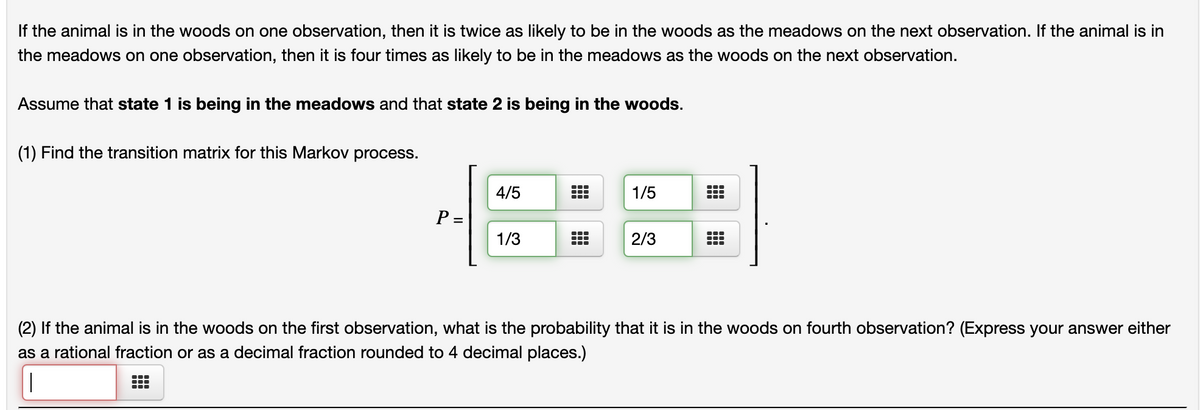If the animal is in the woods on one observation, then it is twice as likely to be in the woods as the meadows on the next observation. If the animal is in the meadows on one observation, then it is four times as likely to be in the meadows as the woods on the next observation. Assume that state 1 is being in the meadows and that state 2 is being in the woods. (1) Find the transition matrix for this Markov process. 4/5 1/5 P = 1/3 2/3 (2) If the animal is in the woods on the first observation, what is the probability that it is in the woods on fourth observation? (Express your answer either as a rational fraction or as a decimal fraction rounded to 4 decimal places.)
If the animal is in the woods on one observation, then it is twice as likely to be in the woods as the meadows on the next observation. If the animal is in the meadows on one observation, then it is four times as likely to be in the meadows as the woods on the next observation. Assume that state 1 is being in the meadows and that state 2 is being in the woods. (1) Find the transition matrix for this Markov process. 4/5 1/5 P = 1/3 2/3 (2) If the animal is in the woods on the first observation, what is the probability that it is in the woods on fourth observation? (Express your answer either as a rational fraction or as a decimal fraction rounded to 4 decimal places.)
Linear Algebra: A Modern Introduction
4th Edition
ISBN:9781285463247
Author:David Poole
Publisher:David Poole
Chapter3: Matrices
Section3.7: Applications
Problem 12EQ:
12. Robots have been programmed to traverse the maze shown in Figure 3.28 and at each junction...
Related questions
Question
Please solve and show soution for question 2

Transcribed Image Text:If the animal is in the woods on one observation, then it is twice as likely to be in the woods as the meadows on the next observation. If the animal is in
the meadows on one observation, then it is four times as likely to be in the meadows as the woods on the next observation.
Assume that state 1 is being in the meadows and that state 2 is being in the woods.
(1) Find the transition matrix for this Markov process.
4/5
1/5
P =
1/3
2/3
(2) If the animal is in the woods on the first observation, what is the probability that it is in the woods on fourth observation? (Express your answer either
as a rational fraction or as a decimal fraction rounded to 4 decimal places.)
|
Expert Solution
This question has been solved!
Explore an expertly crafted, step-by-step solution for a thorough understanding of key concepts.
This is a popular solution!
Trending now
This is a popular solution!
Step by step
Solved in 2 steps with 1 images

Recommended textbooks for you

Linear Algebra: A Modern Introduction
Algebra
ISBN:
9781285463247
Author:
David Poole
Publisher:
Cengage Learning

Elementary Linear Algebra (MindTap Course List)
Algebra
ISBN:
9781305658004
Author:
Ron Larson
Publisher:
Cengage Learning

Linear Algebra: A Modern Introduction
Algebra
ISBN:
9781285463247
Author:
David Poole
Publisher:
Cengage Learning

Elementary Linear Algebra (MindTap Course List)
Algebra
ISBN:
9781305658004
Author:
Ron Larson
Publisher:
Cengage Learning